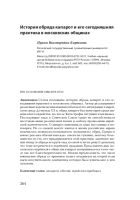История обряда капарот и его сегодняшняя практика в московских общинах
Translated Title
The History of the Kaparot Ritual and Its Current Practice in Moscow Communities
Author(s)
Publication Name
Publication Date
Abstract
Статья посвящена истории обряда капарот и его сегодняшней практике в московских общинах. Автор рассматривает различные версии возникновения обычая и его интеграции в еврейскую среду. До начала XX в. обряд капарот был популярен среди ашкеназского еврейства, но после Катастрофы ситуация изменилась.
Последующие годы в Советском Союзе также не способствовали восстановлению религиозной жизни и любому проявлению еврейской идентичности. О капарот напоминали лишь пословицы и поговорки. Но со сменой власти многое в жизни российских евреев изменилось, появилась возможность «вспомнить» обряд. Однако в новых реалиях обычай выглядел совсем не гуманно, поэтому большинство из тех, кто придерживается этой практики, заменяют живую птицу (в обряде ее крутят над головой и затем режут) деньгами, что тоже встречается в еврейской традиции. Представителями московского еврейского общества капарот воспринимается в том числе как акт благотворительности. Можно предположить, что такое
понимание обряда со временем может отодвинуть на второй план идею искупительного замещения, которая была изначально в нем заложена.
Последующие годы в Советском Союзе также не способствовали восстановлению религиозной жизни и любому проявлению еврейской идентичности. О капарот напоминали лишь пословицы и поговорки. Но со сменой власти многое в жизни российских евреев изменилось, появилась возможность «вспомнить» обряд. Однако в новых реалиях обычай выглядел совсем не гуманно, поэтому большинство из тех, кто придерживается этой практики, заменяют живую птицу (в обряде ее крутят над головой и затем режут) деньгами, что тоже встречается в еврейской традиции. Представителями московского еврейского общества капарот воспринимается в том числе как акт благотворительности. Можно предположить, что такое
понимание обряда со временем может отодвинуть на второй план идею искупительного замещения, которая была изначально в нем заложена.
Translated Abstract
The article is devoted to the history of the Kaparot ritual and its current practice in Moscow communities. The first part of the text deals with the history of the custom: from its emergence to becoming a conventional element of the Jewish environment, and the controversies around it. Up to the beginning of the XX century the ritual was very
popular among Ashkenazi Jews, but in the wake of the Holocaust the situation changed drastically. The post-Was Soviet regime didn’t allow for the revival of religious life in general and wasn’t encouraging to any manifestations of the Jewish identity in particular. Proverbs and sayings were all that remained of the Kaparot ceremony. After the collapse of the Soviet Union, the situation of the Russian Jews altered again, and they could return to this old tradition, among others, as well. In the new reality, however, the ritual mistreatment of a chicken looked completely
inhumane, so the majority of those who still wanted to practice the Kaparot, would actually replace the bird with money — also in compliance with an old Jewish custom. Today many members of the Moscow Jewish
community perceive the Kaparot as an act of charity. Thus, it is reasonable to expect that this, “alternative” take on the custom will in time become mainstream, turning marginal the original meaning of the Kaparot as a redeeming substitute.
popular among Ashkenazi Jews, but in the wake of the Holocaust the situation changed drastically. The post-Was Soviet regime didn’t allow for the revival of religious life in general and wasn’t encouraging to any manifestations of the Jewish identity in particular. Proverbs and sayings were all that remained of the Kaparot ceremony. After the collapse of the Soviet Union, the situation of the Russian Jews altered again, and they could return to this old tradition, among others, as well. In the new reality, however, the ritual mistreatment of a chicken looked completely
inhumane, so the majority of those who still wanted to practice the Kaparot, would actually replace the bird with money — also in compliance with an old Jewish custom. Today many members of the Moscow Jewish
community perceive the Kaparot as an act of charity. Thus, it is reasonable to expect that this, “alternative” take on the custom will in time become mainstream, turning marginal the original meaning of the Kaparot as a redeeming substitute.
Topics
Main Topic: Other Ritual Religious Observance and Practice Festivals and Holidays Charity / Tzedakah
Genre
Geographic Coverage
Original Language
Page Number / Article Number
284-297
DOI
Bibliographic Information
История обряда капарот и его сегодняшняя практика в московских общинах. 2019: 284-297. https://archive.jpr.org.uk/10.31168/2658-3380.2019.19.5.3




